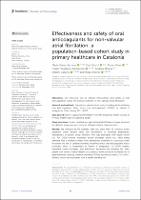| dc.contributor | IDIAP Jordi Gol |
| dc.contributor.author | Giner-Soriano, Maria |
| dc.contributor.author | Ouchi, Dan |
| dc.contributor.author | Vives, Roser |
| dc.contributor.author | Vilaplana-Carnerero, Carles |
| dc.contributor.author | Molina-Nadal, Andrea |
| dc.contributor.author | Vallano, Antonio |
| dc.contributor.author | Morros, Rosa |
| dc.date.accessioned | 2023-09-19T10:30:52Z |
| dc.date.available | 2023-09-19T10:30:52Z |
| dc.date.issued | 2023-09-15 |
| dc.identifier.citation | Giner-Soriano M, Ouchi D, Vives R, Vilaplana-Carnerero C, Molina A, Vallano A, et al. Effectiveness and safety of oral anticoagulants for non-valvular atrial fibrillation: a population-based cohort study in primary healthcare in Catalonia. Front Pharmacol;14:1237454. |
| dc.identifier.issn | 1663-9812 |
| dc.identifier.uri | https://hdl.handle.net/11351/10311 |
| dc.description | Anticoagulantes orales; Fibrilación auricular; Atención primaria de salud |
| dc.format.mimetype | pdf |
| dc.language.iso | eng |
| dc.publisher | Frontiers Media |
| dc.relation.ispartofseries | Frontiers in Pharmacology;14 |
| dc.rights | Attribution-NonCommercial-NoDerivatives 4.0 International |
| dc.rights.uri | http://creativecommons.org/licenses/by-nc-nd/4.0/ |
| dc.source | Scientia |
| dc.subject | Anticoagulants (Medicina) |
| dc.subject | Malalties cerebrovasculars - Prevenció |
| dc.subject | Fibril·lació auricular - Tractament |
| dc.subject.mesh | Anticoagulants |
| dc.subject.mesh | Stroke |
| dc.subject.mesh | /prevention & control |
| dc.subject.mesh | Atrial Fibrillation |
| dc.subject.mesh | /drug therapy |
| dc.title | Effectiveness and safety of oral anticoagulants for non-valvular atrial fibrillation: a population-based cohort study in primary healthcare in Catalonia |
| dc.type | info:eu-repo/semantics/article |
| dc.identifier.doi | 10.3389/fphar.2023.1237454 |
| dc.subject.decs | anticoagulantes |
| dc.subject.decs | accidente cerebrovascular |
| dc.subject.decs | /prevención & control |
| dc.subject.decs | fibrilación atrial |
| dc.subject.decs | /farmacoterapia |
| dc.relation.publishversion | https://doi.org/10.3389/fphar.2023.1237454 |
| dc.type.version | info:eu-repo/semantics/publishedVersion |
| dc.audience | Professionals |
| dc.contributor.authoraffiliation | [Giner-Soriano M, Ouchi D] Fundació Institut Universitari per a la Recerca a l’Atenció Primària de Salut Jordi Gol i Gurina (IDIAPJGol), Barcelona, Spain. Universitat Autònoma de Barcelona, Barcelona, Spain. [Vives R, Molina A] Department of Pharmacology, Therapeutics and Toxicology, Universitat Autònoma de Barcelona, Barcelona, Spain. Medicines Department, Catalan Healthcare Service, Barcelona, Spain. [Vilaplana-Carnerero C] Fundació Institut Universitari per a la Recerca a l’Atenció Primària de Salut Jordi Gol i Gurina (IDIAPJGol), Barcelona, Spain. Universitat Autònoma de Barcelona, Barcelona, Spain. Plataforma SCReN, UIC IDIAPJGol, Barcelona, Spain. Department of Medicine, University of Barcelona, Barcelona, Spain. [Vallano A] Department of Pharmacology, Therapeutics and Toxicology, Universitat Autònoma de Barcelona, Barcelona, Spain. Medicines Department, Catalan Healthcare Service, Barcelona, Spain. Institut Català de la Salut, Barcelona, Spain. [Morros R] Fundació Institut Universitari per a la Recerca a l’Atenció Primària de Salut Jordi Gol i Gurina (IDIAPJGol), Barcelona, Spain. Department of Pharmacology, Therapeutics and Toxicology, Universitat Autònoma de Barcelona, Barcelona, Spain. Plataforma SCReN, UIC IDIAPJGol, Barcelona, Spain. Institut Català de la Salut, Barcelona, Spain |
| dc.rights.accessrights | info:eu-repo/semantics/openAccess |

 Área privada
Área privada Contacto
Contacto







